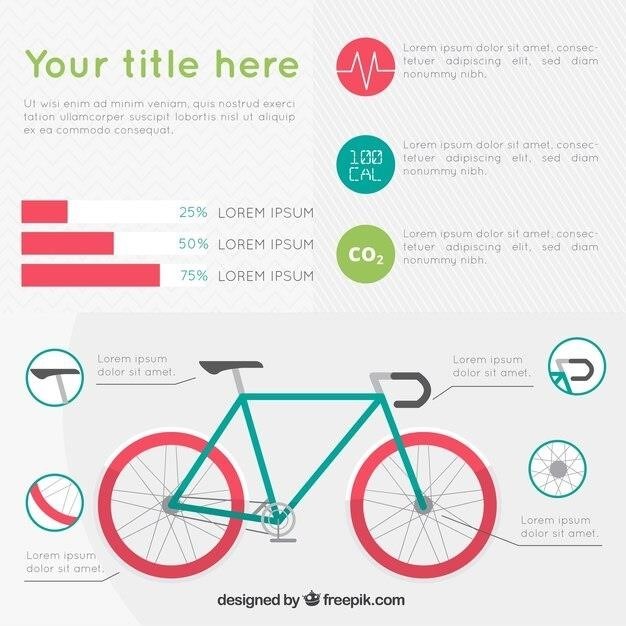Road Bike Size Guide (cm)
This guide helps you find the perfect road bike frame size in centimeters, based on your height and inseam. Proper sizing ensures comfort, efficiency, and optimal power transfer for a more enjoyable riding experience. Use our charts and tips to find your ideal fit.
Choosing the Right Bike Type
Before diving into specific measurements, it’s crucial to identify the type of road bike that aligns with your riding style and goals. Road bikes generally fall into several categories⁚
- Racing Road Bikes⁚ Designed for speed and aggressive riding positions, these bikes feature longer top tubes and lower front ends. They prioritize aerodynamics and efficient power transfer, ideal for competitive cyclists or those seeking exhilarating performance.
- Sportive/Endurance Road Bikes⁚ Emphasizing comfort for longer rides, these bikes offer shorter top tubes and higher front ends, promoting a more relaxed posture. They are well-suited for recreational cyclists, long-distance riders, and those prioritizing comfort over pure speed.
- Adventure/Gravel Bikes⁚ Built for versatility and exploring various terrains, these bikes combine the drop-bar setup of road bikes with wider tire clearance and more robust frames. They handle paved roads, gravel paths, and light trails, making them ideal for adventurous riders seeking off-the-beaten-path experiences.
- Cyclocross Bikes⁚ Designed for cyclocross racing, these bikes feature knobby tires, disc brakes, and a slightly more upright geometry than racing road bikes. They excel in off-road conditions and are suitable for riders interested in a blend of road and trail riding.
Understanding the nuances of each type helps narrow down the selection process and ensures you choose a bike that complements your riding preferences and intended use.
Determining Your Measurements
Accurate measurements are essential for determining the correct road bike frame size. Two key measurements are crucial⁚
- Inseam⁚ Stand against a wall with your feet shoulder-width apart. Place a book between your legs, spine-up, as if sitting on a saddle. Measure from the floor to the top of the book in centimeters. This represents your inseam.
- Height⁚ Stand against a wall without shoes. Have someone mark the top of your head. Measure from the floor to the mark in centimeters. This is your overall height.
While these are the primary measurements, consider these additional factors for a more precise fit⁚
- Arm Length⁚ Measure from your shoulder to your fingertips.
- Torso Length⁚ Measure from the top of your hip bone to the base of your neck.
- Flexibility⁚ Your level of flexibility influences your reach and comfort on the bike.
Recording these measurements provides a comprehensive profile for selecting the right frame size and ensuring a comfortable and efficient riding experience.
Calculating Frame Size (cm)
Once you have your inseam measurement (in cm), you can estimate your road bike frame size using a simple formula. Multiply your inseam by 0.70 (or 0.67 for a more traditional fit). This calculation provides an approximate frame size in centimeters.
Example⁚
Inseam = 85cm
Frame Size = 85cm * 0.70 = 59.5cm
This result suggests a frame size around 59-60cm. Remember, this is a starting point. Consult manufacturer’s sizing charts for specific models, as geometries vary. Some manufacturers also offer different frame sizes based on “stack and reach” measurements, which consider torso and arm length. These provide a more precise fit than inseam alone.
While calculations offer a good estimate, a professional bike fit is always recommended for optimal performance and comfort.
Using Online Bike Size Calculators
Several online bike size calculators simplify the process of determining your ideal frame size. These tools typically require inputting key measurements like your height, inseam, and sometimes arm length or torso length. The calculator then uses algorithms, often incorporating manufacturer-specific data, to suggest a suitable frame size (in cm) and sometimes even recommend specific bike models.
While convenient, online calculators provide estimates. Treat these suggestions as a starting point, not a definitive answer. Bike geometry varies between brands, even within the same size category. A 56cm frame from one manufacturer might feel different from a 56cm frame from another due to variations in top tube length, head tube angle, and other geometric factors.
Always cross-reference the calculator’s results with the manufacturer’s sizing chart for the specific bike model you’re considering. A professional bike fit remains the gold standard for achieving the most personalized and comfortable riding position.

Understanding Manufacturer Sizing Charts
Each bicycle manufacturer provides specific sizing charts for their road bikes. These charts are crucial for determining the correct frame size (cm) for your body and riding style. While general size guides offer a starting point, manufacturer charts provide tailored recommendations based on the unique geometry of their bikes.
Most manufacturer charts correlate rider height and inseam to frame size. Some also incorporate other measurements like arm length or torso length for a more precise fit. Pay close attention to the units used (cm or inches) and how the manufacturer defines their measurements (e.g., center-to-top or center-to-center for seat tube length).
Beyond the basic size recommendations, some manufacturers offer detailed geometry charts specifying key measurements like stack, reach, and effective top tube length. Understanding these measurements helps fine-tune your fit and achieve optimal riding comfort and performance. If you’re between sizes or have specific fit requirements, consult with a professional bike fitter or contact the manufacturer directly for personalized advice.
Considering Standover Height
Standover height is a crucial measurement in road bike fitting, ensuring safety and comfort. It refers to the clearance between the top tube of the frame and your crotch when standing over the bike with feet flat on the ground. A proper standover height allows you to dismount quickly and safely in emergencies and provides comfortable maneuvering at stops.
For road bikes, aim for 2-3 cm of clearance between the top tube and your crotch. This provides sufficient space for unexpected situations without compromising riding position. Mountain and commuter bikes typically require more clearance (3-4 cm) due to varied terrain and potential obstacles.
To determine your required standover height, measure your inseam in centimeters. Consult manufacturer sizing charts, which often list standover height for each frame size. When test riding a bike, ensure there’s adequate clearance. If you feel cramped or uncomfortable, consider a smaller frame size or a bike with a sloping top tube design, which offers more standover clearance.
Road Bike Frame Geometry
Road bike frame geometry significantly influences riding style and comfort. Key measurements include stack and reach, which determine the rider’s position. Stack height measures the vertical distance from the bottom bracket to the top of the head tube, influencing handlebar height. Reach measures the horizontal distance from the bottom bracket to the center of the head tube, affecting how stretched out the rider feels.
Bikes with longer reach and lower stack create a more aggressive, aerodynamic riding position, favored by racers. Shorter reach and higher stack result in a more upright, comfortable posture, suitable for long-distance riding or cyclists seeking a less strenuous experience. Other crucial geometry factors include head tube angle, seat tube angle, and chainstay length, all impacting handling and responsiveness.
When choosing a road bike, consider your riding style and flexibility. Manufacturer geometry charts provide detailed measurements for each frame size. Comparing these measurements helps you find a bike that aligns with your preferences and physical characteristics, ensuring a comfortable and efficient ride.
Men’s Road Bike Size Chart (cm)
This chart provides a general guideline for men’s road bike frame sizes based on height. Remember that this is a starting point, and individual proportions may vary. Always consult manufacturer’s specific sizing charts for the most accurate fit.
| Height (cm) | Frame Size (cm) |
|---|---|
| 160 ー 168 | 49 ー 51 |
| 168 ー 175 | 51 ⏤ 53 |
| 175 ⏤ 183 | 53 ⏤ 55 |
| 183 ⏤ 190 | 55 ⏤ 57 |
| 190 ⏤ 198 | 57 ⏤ 59 |
It’s crucial to consider inseam measurement and other factors like riding style and flexibility. A professional bike fit is highly recommended for personalized guidance and optimal performance. This chart serves as a preliminary tool to help you navigate the selection process.
Women’s Road Bike Size Chart (cm)
This chart offers a general guideline for women’s road bike frame sizes based on height. Keep in mind that women’s specific bike geometry often considers proportions like shorter torsos and limbs. This chart provides a starting point, and individual fit may vary.
| Height (cm) | Frame Size (cm) |
|---|---|
| 150 ー 158 | 47 ー 49 |
| 158 ⏤ 165 | 49 ⏤ 51 |
| 165 ー 173 | 51 ー 53 |
| 173 ⏤ 180 | 53 ー 55 |
| 180 ⏤ 188 | 55 ー 57 |
Always consult manufacturer’s specific sizing charts and consider factors like inseam measurement and riding style. A professional bike fit is highly recommended, especially if you’re between sizes or have specific fit needs. This chart is a preliminary guide to help you in the selection process.
Importance of Test Riding
While size charts provide a helpful starting point, a test ride is crucial for confirming proper road bike fit. Charts offer general guidelines, but individual body proportions and riding preferences significantly influence comfort and performance.
During a test ride, pay close attention to reach, handlebar comfort, and overall riding position. Does the bike feel too stretched out or cramped? Are you able to comfortably reach the handlebars and brake levers? A test ride allows you to assess these critical aspects.
Don’t hesitate to experiment with different sizes or models during your test ride. A knowledgeable bike shop staff can provide valuable insights and adjustments. Ultimately, a test ride empowers you to choose the road bike that feels best and supports your cycling goals. It transforms data into tangible experience, leading to informed decisions and enhanced riding enjoyment.
Adjustments and Fine-tuning
Even after selecting the right size road bike frame, fine-tuning is essential for optimal comfort and performance. Minor adjustments can significantly impact your riding experience. Consider adjusting saddle height, fore-aft position, and handlebar reach.
Saddle height should allow for a slight bend in your knee at the bottom of the pedal stroke. Adjust fore-aft position to optimize power transfer and knee comfort over the pedal axle. Handlebar reach affects your back angle and overall riding posture.
Cleat position on your cycling shoes also influences pedaling efficiency and comfort. Experiment with minor adjustments to find the optimal alignment for your feet. Don’t hesitate to consult a professional bike fitter for personalized guidance.
Fine-tuning ensures a harmonious relationship between you and your bike, maximizing comfort, preventing injuries, and enhancing cycling performance. These adjustments transform a well-chosen bike into a personalized riding machine.

Common Sizing Mistakes
Choosing a road bike based solely on height can lead to an improper fit. Neglecting inseam measurements is a frequent error, as it significantly impacts standover height and saddle position. Overlooking frame geometry, specifically reach and stack, can result in an uncomfortable or inefficient riding posture.
Another common mistake is fixating on generic size charts without considering manufacturer variations. Different brands have unique sizing conventions. Relying solely on “small,” “medium,” or “large” designations without checking specific measurements can be misleading. Failing to test ride before purchasing is a major oversight.
A test ride allows you to experience the bike’s feel and make informed decisions about adjustments. Ignoring professional advice is also detrimental. A bike fitter can identify subtle issues and recommend adjustments for optimal comfort and performance. Avoid these pitfalls for a more enjoyable and efficient cycling experience.
